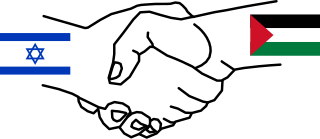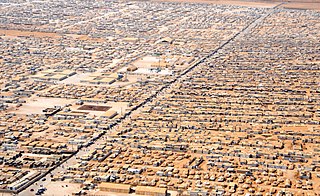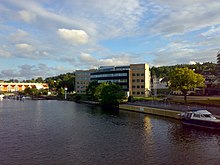
Civil defence or civil protection is an effort to protect the citizens of a state from military attacks and natural disasters. It uses the principles of emergency operations: prevention, mitigation, preparation, response, or emergency evacuation and recovery. Programs of this sort were initially discussed at least as early as the 1920s and were implemented in some countries during the 1930s as the threat of war and aerial bombardment grew. It became widespread after the threat of nuclear weapons was realized.

The United Nations High Commissioner for Refugees (UNHCR) is a United Nations agency with the mandate to protect refugees, forcibly displaced communities and stateless people, and assist in their voluntary repatriation, local integration or resettlement to a third country. UNHCR‘s mandate does not apply to Palestinian refugees, who are assisted by UNWRA.

Tønsberg[ˇtœnsbær(ɡ)](listen), historically Tunsberg, is a city and municipality in Vestfold in Vestfold og Telemark county, southern Norway, located around 102 kilometres south-southwest of Oslo on the western coast of the Oslofjord near its mouth onto the Skagerrak. The administrative centre of the municipality is the town of Tønsberg. The municipality has a population of 41,239 and covers an area of 107 square kilometres.

The Interim Agreement on the West Bank and the Gaza Strip commonly known as Oslo II or Oslo 2, was a key and complex agreement in the Israeli–Palestinian peace process. Because Oslo II was signed in Taba, it is sometimes called the Taba Agreement. The Oslo Accords envisioned the establishment of a Palestinian interim self-government in the Palestinian territories but did not promise an independent Palestinian state. Oslo II created the Areas A, B and C in the West Bank. The Palestinian Authority was given some limited powers and responsibilities in the Areas A and B and a prospect of negotiations on a final settlement based on Security Council Resolutions 242 and 338. The Accord was officially signed on 28 September 1995.

The National Security Authority (NSM) is a Norwegian security agency (Direktorat) established on 1 January 2003 as the successor to Forsvarets sikkerhetsstab (FO/S). It is responsible for preventive national security, ICT security matters, including the national computer emergency response team (NorCERT), identifying national objects of special interest and reducing their vulnerability to internal and external threats. The agency performs threat analysis at the national level, and is also known to work with experts on computer security and with data encryption. The cooperation with the Police Security Agency (PST) and the Norwegian Intelligence Service (NIS) has been identified as a very important part of the task of maintaining an overview of potential threats to objects, and instituting proactive activities.
The Royal Norwegian Ministry of Defence is a Norwegian government ministry in charge of the formation and implementation of national security and defence policy, and for the overall management and control of the activities of subordinate agencies. The ministry is located at Glacisgata 1, Oslo, inside Akershus festning. The ministry is headed by the politically appointed Minister of Defence, currently Frank Bakke-Jensen. The ministry controls a large group of defence-related agencies, not to be related with Ministry of Foreign Affairs that controls all intelligence-related agencies in the country.

Dadaab is a semi-arid town in Garissa County, Kenya. It is the site of a UNHCR base hosting 211,365 registered refugees and asylum seekers in three camps as of the 13 May 2019, making it the third-largest such complex in the world. The center is run by the United Nations High Commissioner for Refugees, and its operations are financed by foreign donors. In 2013, UNHCR, the governments of Kenya and Somalia signed a tripartite agreement facilitating the repatriation of Somali refugees at the complex.

Russian President Boris Yeltsin established the Ministry of the Russian Federation for Affairs for Civil Defence, Emergencies and Elimination of Consequences of Natural Disasters, also known as The Ministry of Emergency Situations, MChS, or internationally as EMERCOM on January 10, 1994. One school of thought traces the origins of the agency to December 27, 1990, when the RSFSR established the Russian Rescue Corps and assigned it the mission of rapid response in the case of emergencies.

The United States Under Secretary of Defense for Policy (USDP) is a high level civilian official in the United States Department of Defense. The Under Secretary of Defense for Policy is the principal staff assistant and adviser to both the Secretary of Defense and the Deputy Secretary of Defense for all matters concerning the formation of national security and defense policy.

The Norwegian Water Resources and Energy Directorate is a Norwegian government agency established in 1921. It is under the Ministry of Petroleum and Energy and regulates the country's water resources and energy supply. Its mandate includes contingency planning for floods, serving as a centre of expertise for hydrology, research and development, and increasing energy efficiency. It is a member of the Council of European Energy Regulators.

The Danish Emergency Management Agency (DEMA) is a Danish governmental agency under the Ministry of Defence. Its principal task is to manage an operational part who work out of six Emergency Management Centres, and administrative and legalizing part, who supervises the national and municipal rescue preparedness and advises the authorities on matters of preparedness. DEMA works in closely structured co-operation with the EU, UN and several neighbouring countries.
The Accident Investigation Board Norway is a government agency which is responsible for investigating transport-related accidents within Norway. Specifically, it investigates aviation accidents and incidents, rail accidents, maritime accidents and select traffic accidents. All investigations aim to find underlying causes and to improve safety; criminal investigation is not part of AIBN's mandate. Subordinate to the Ministry of Transport and Communications, the agency is located on the premises of Kjeller Airport in Skedsmo.

The Dutch Safety Board is an organisation based in The Hague, Netherlands. The first DSB Chairman was Pieter van Vollenhoven, who served from 2005 until 2011. He was succeeded by Tjibbe Joustra, who retired in 2019; he was succeeded by former Finance Minister Jeroen Dijsselbloem.

The Swedish Civil Contingencies Agency is a Swedish administrative authority, organised under the Ministry of Defence. The agency is responsible for issues concerning civil protection, public safety, emergency management and civil defence. Responsibility refers to measures taken before, during and after an emergency or crisis. MSB work in close cooperation with the municipalities, the county councils, other authorities, organisations and the private sector to achieve increased safety and security at all levels of society. This is done through education, support, training exercises, regulation and supervision.
By January 2011 the United Nations High Commissioner for Refugees (UNHCR) estimated that there are 262,900 Sudanese refugees in Chad. The majority of them left Sudan escaping from the violence of the ongoing Darfur crisis, which began in 2003. UNHCR has given the Sudanese refugees shelter in 12 different camps situated along the Chadian-Sudanese border. The most pressing issues UNHCR has to deal with in the refugee camps in Chad are related to insecurity in the camps,, malnutrition, access to water, HIV and AIDS, and education.
Refugees of the Syrian Civil War are citizens and permanent residents of Syria, who have fled their country over the course of the Syrian Civil War. The pre-war population of the Syrian Arab Republic was estimated at 22 million (2017), including permanent residents. Of that number, the United Nations (UN) identified 13.5 million (2016) as displaced persons, requiring humanitarian assistance. Of these, since start of the Syrian Civil War in 2011 more than six million (2016) were internally displaced, and around five million (2016) had crossed into other countries, with most seeking asylum or placed in Syrian refugee camps established in Turkey (3,614,108), Lebanon (929,624), Jordan (662,010), Egypt (131,433), and other countries.

The Permanent Structured Cooperation (PESCO) is the part of the European Union's (EU) security and defence policy (CSDP) in which 25 of the 28 national armed forces pursue structural integration. Based on Article 42.6 and Protocol 10 of the Treaty on European Union, introduced by the Treaty of Lisbon in 2009, PESCO was first initiated in 2017. The initial integration within the PESCO format is a number of projects planned to launch in 2018.

Zaatari is a refugee camp in Jordan, located 10 kilometres (6.2 mi) east of Mafraq, which has gradually evolved into a permanent settlement; it is the world’s largest camp for Syrian refugees. It was first opened on 28 July 2012 to host Syrians fleeing the violence in the ongoing Syrian Civil War that erupted in March 2011. It is connected to the road network by a short road which leads to Highway 10.

Syrian refugee camps and shelters are temporary settlements built to receive internally displaced people and refugees of the Syrian Civil War. Of the estimated 7 million persons displaced within Syria, only a small minority live in camps or collective shelters. Similarly, of the 6 million refugees, only about 10 percent live in refugee camps, with the vast majority living in both urban and rural areas of neighboring countries. Beside Syrians, they include Iraqis, Palestinians, Kurds, Yazidis, individuals from Somalia, and a minority of those who fled the Yemeni and Sudanese civil wars.
Refugees in Jordan rose with the uprising against the Syrian government and its President Bashar al-Assad. Close to 13,000 Syrians per day began pouring into Jordan to reside in its refugee camps.















